
Busselton is a city in the South West region of the state of Western Australia approximately 220 km (140 mi) south-west of Perth. Busselton has a long history as a popular holiday destination for Western Australians; however, the closure of the Busselton Port in 1972 and the contemporaneous establishment of the nearby Margaret River wine region have seen tourism become the dominant source of investment and development, supplemented by services and retail. The city is best known for the Busselton Jetty, the longest wooden jetty in the Southern Hemisphere.
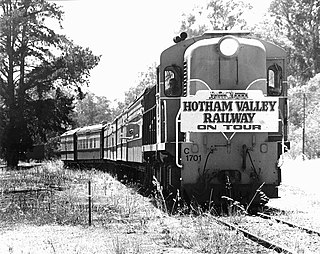
The townsite of Wonnerup is located 219 kilometres (136 mi) south of Perth and 10 kilometres (6 mi) east of Busselton. It was gazetted a townsite in 1856, deriving its name from the nearby Wonnerup Inlet.
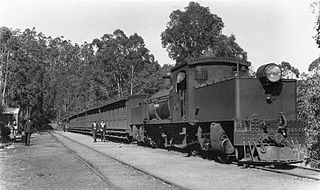
The Mundaring Weir branch railway was constructed from Mundaring, Western Australia to the site of the Mundaring Weir, and opened on 1 June 1898.
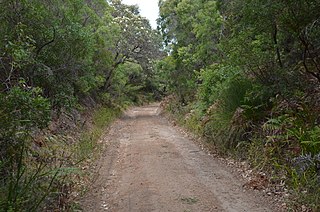
The Flinders Bay branch railway, also known as the Boyanup to Flinders Bay section ran between Boyanup and Flinders Bay, in South Western Western Australia. The section from Flinders Bay to Busselton has now been converted into a rail trail for bushwalkers and cyclists, called the Wadandi Trail.

Railways in Western Australia were developed in the 19th century both by the Government of Western Australia and a number of private companies. Today passenger rail services are controlled by the Public Transport Authority through Transperth, which operates public transport in Perth, and Transwa, which operates country passenger services. Journey Beyond operates the Indian Pacific.

The network of railway lines in Western Australia associated with the timber and firewood industries is as old as the mainline railway system of the former Western Australian Government Railways system.
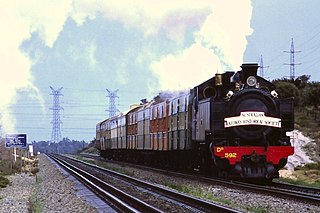
The WAGR Dd class was a class of 4-6-4T tank locomotive operated by the Western Australian Government Railways (WAGR) between 1946 and 1972.
The Adelaide Timber Company was a family saw mill company that had timber mills and timber railway lines across a number of locations in Australia in the late nineteenth and early twentieth century.
Millars' Karri and Jarrah Company (1902) Limited, commonly known as Millars, was a Western Australian focused timber and timber railway company.
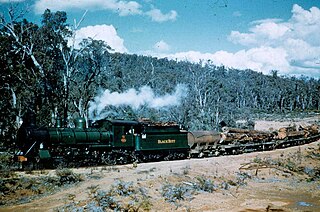
The WAGR C class was a class of light axle load steam locomotives operated by the Western Australian Government Railways (WAGR) between 1902 and 1961. A total of 22 were built in two batches.

The WAGR E class was a two-member class of 2-4-4-2T double-Fairlie locomotives operated by the Western Australian Government Railways (WAGR) between 1881 and 1892.

The WAGR A class was a class of 2-6-0 steam locomotives designed by Beyer, Peacock & Co and operated by the Western Australian Government Railways (WAGR) between 1881 and 1955.
The Nannup branch railway, also known as the Wonnerup to Nannup railway, was a branch line of the Western Australian Government Railways (WAGR) between Wonnerup and Nannup.

The Ballaarat tramline, also known as the Lockville–Yoganup railway, was the first railway in Western Australia, constructed in 1871 by the Western Australian Timber Company. The railway was used to transport timber from forests in the South West to the company's jetty at Lockville using the Ballaarat steam engine.

Neil McNeil was a prominent Australian businessman who was significant in the development of railways across Australia along with Western Australia's timber industry.

The Ballaarat steam engine, built by James Hunt's Victoria Foundry in the city of Ballarat, Victoria in 1871, was the first 1067 mm gauge locomotive built in Australia. It was purchased by the Western Australian Timber Company, which was awarded one of only three milling concessions granted in the colony. The company had 181,500 acres to mill at Yoganup, near the town of Busselton.

The Northcliffe branch, also known as the Northcliffe section or Picton to Northcliffe line, is the railway route between Picton and Northcliffe in Western Australia.

WAGR G class G233 Leschenault Lady is a preserved 2-6-0 steam locomotive, built in 1898 by James Martin & Co of Gawler, South Australia, for the Western Australian Government Railways (WAGR). It is the third oldest Australian-built steam locomotive still in operational order, after Victorian Railways Y class 112 and WAGR A class 15.
Yoganup is a rural locality of the City of Busselton in the South West region of Western Australia. It is the largest locality in the City of Busselton but has the second-lowest population, being almost completely forested. Whicher National Park is almost completely located within Yoganup and the small town of Jarrahwood is completely surrounded by the locality, but not part of it. The Vasse Highway passes through the south-west of Yoganup.

The Jarrahdale to Rockingham railway line was a private timber railway line connecting the timber mill at Jarrahdale with the port at Rockingham. It was the second railway line to operate in Western Australia, opening in 1872. From 1893, it connected to the South Western Railway at Mundijong. The section from Mundijong to Rockingham was removed in 1950 but the Jarrahdale to Mundijong section remained in operation until 1962.















